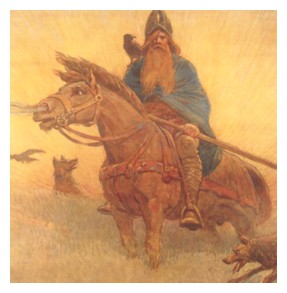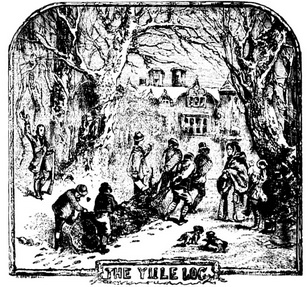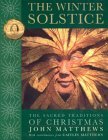|
Yule Log - Bringing in the Yule
A central part of the interplay between darkness and light, the natural and the human worlds, which is so central to the celebration of Midwinter, is the burning of the Yule Log. The origins of this ceremony are vague, though they probably spring from the Norse celebration of Midwinter which, like the Roman Saturnalia, lasted for around two weeks. The actual season was reckoned to last from mid November to the end of January, more in keeping with the Celtic Wintertide, which extended from Samhain on November 1st to Imbolc on February 1st. The word yule has been variously interpreted as deriving from the Saxon word hweol, "wheel,' referring in this context both to the circling of the year and the circular motion of the sun. A more distinctive meaning here may be to the wheels of the Norse god Odin's chariot, in which he sped through the air in search of the souls of recently dead heroes. 

One of the many names born by Odin was Jolnir, which is etymologically associated with Yule, and there is no lack of evidence to suggest that the Midwinter festival among the peoples of the North (and later in England) included some kind of sacrifice to the god. At one time this festival may have included other sacrifices, but in the records that have survived it seems to have been a time when cattle were slaughtered in large numbers. The early Christian historian, the Venerable Bede, referred to November as Blormonath (Blood Month) because of this. The word yule can also mean "a loud shout," which may be linked to the custom, still practiced until the middle of the seventeenth century, of shouting "Yole" in church at the end of the Christmas Day service. This was perhaps less in celebration of "Yule" than as a warding off of the god and as part of a distant memory of the ancient Teutonic Solstitial festivals once celebrated and gradually absorbed into the more general Christmas celebrations. The Yule Log itself is above all a reminder of the importance of fire in the depth of the cold and darkness of Midwinter. Throughout Europe and the United States the tradition continued until recent times (indeed it is by no means dead today). Accounts of the traditions surrounding the Cutting, bringing in, and kindling of the log are plentiful, as in the following account by the poet Frederic Mistral, who describes how, on Christmas Eve during his childhood (toward the end of the eighteenth century), his whole family went forth to fetch the log, which had to be cut from a fruit tree in token of the fertility of the next year in the land: Walking in line we bore it home, headed by the oldest at one end and I, the last born, bringing up the rear. Three times we made the tour of the kitchen, then, arrived at the flagstones of the hearth, my father solemnly poured over the log a glass of wine, with the dedicatory words:Joy! Joy! May God shower joy upon us, my dear children. Christmas brings us all good things. God give us grace to see the New Year, and if we do not increase in numbers may we at all events not decrease. In chorus we responded: "Joy, joy, joy! " and lifted the log on the fire dogs. Then as the first flame leapt up my father would cross himself saying, "Burn the log, O fire," and with that we all sat down at the table.
This beautiful illustrated book by Celtic and Arthurian folklorist John Matthews presents the history of modern Christmas rituals. Trying to combat the commercialization of Christmas, Matthews explains how the solstice is celebrated around the world and how the dates of Christmas are different in different cultures.
He discusses the traditions of Santa Claus, Saint Nicholas, and others, including mention of a short story featuring Santa Claus's evil twin, Bob. Also included is information on the Twelve Days of Christmas, solstice animals, and celebrations. Each engagingly written chapter contains a celebration for readers to try themselves. Highly recommended.
Yule Log Yule Log Traditions  Custom Search
|

